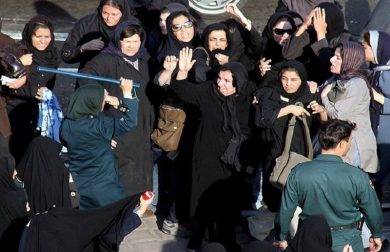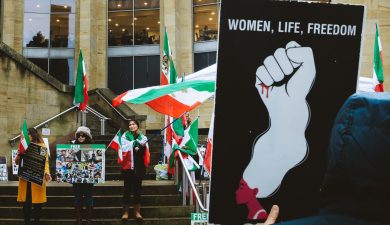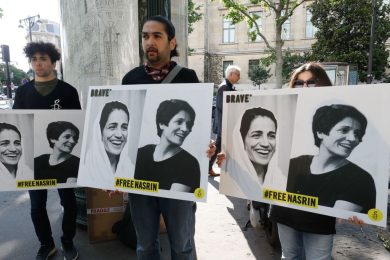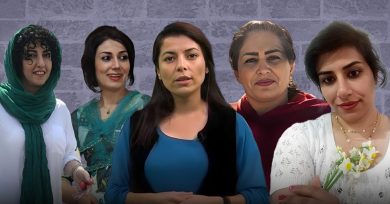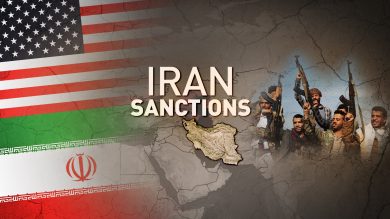In the age of digital connectivity, social media has emerged as a powerful weapon for those fighting oppression. In Iran, where state-controlled media dominates and the Islamic Revolutionary Guard Corps (IRGC) enforces strict censorship, social media platforms have become the primary battleground for women-led resistance.
Iranian women, long subjected to gender-based oppression, have harnessed digital tools to organize protests, share stories, and expose human rights abuses. Platforms like Instagram, Twitter, Telegram, and TikTok have been instrumental in spreading the message of “Women, Life, Freedom”, amplifying voices the regime desperately tries to silence.
This opinion piece explores:
• How social media empowers Iranian women in their resistance.
• The IRGC’s attempts to control and censor digital spaces.
• Key social media campaigns that have shaped the movement.
• The global impact of Iran’s digital resistance and how the international community can support it.
1. Social Media: A Lifeline for Women’s Resistance in Iran
A. Bypassing State-Controlled Media
In Iran, traditional media is tightly controlled by the government. The IRGC censors news, spreading propaganda and misinformation while suppressing reports of human rights abuses. For Iranian women:
• Social media provides a voice in a society where public dissent is dangerous.
• It allows uncensored news, including footage of protests, crackdowns, and state violence, to reach the world.
• Digital platforms help bypass the regime’s narratives, ensuring truthful reporting from the ground.
B. Organizing Protests and Movements
• Platforms like Telegram and WhatsApp are used to coordinate demonstrations and organize strikes.
• Hashtags such as #WomenLifeFreedom and #MahsaAmini have connected millions of Iranians, both inside and outside the country.
• Live-streaming protests on Instagram has allowed instant global visibility, making it harder for the regime to operate in the shadows.
Without social media, many of Iran’s women-led uprisings would have remained invisible to the world.
2. Key Social Media Campaigns Driving the Movement
A. WomenLifeFreedom: The Rallying Cry
The slogan “Women, Life, Freedom” (Zan, Zendegi, Azadi) became the mantra of resistance after the death of Mahsa Amini in 2022. The hashtag #WomenLifeFreedom has:
• Garnered millions of posts globally, bringing international attention to Iran’s struggle.
• Unified various women’s rights campaigns, both inside Iran and among the diaspora.
• Served as a symbol of defiance, representing the rejection of patriarchal rule and the demand for freedom.
B. MyStealthyFreedom: Defying the Hijab Law
Launched by Masih Alinejad, #MyStealthyFreedom became a groundbreaking digital campaign encouraging Iranian women to:
• Post photos without hijab, openly defying Iran’s mandatory dress code.
• Share personal stories of harassment, oppression, and resistance.
• Inspire international solidarity, making the hijab a global symbol of enforced oppression rather than faith.
C. WhiteWednesdays and #No2Hijab
• These campaigns encourage women to wear white on Wednesdays as a silent protest against compulsory hijab laws.
• Videos of women removing hijabs in public have gone viral, showcasing bravery in everyday acts of defiance.
• The campaigns have also led to international protests, highlighting how digital activism transcends borders.
3. The IRGC’s Digital Crackdown
While social media empowers resistance, the IRGC has launched aggressive cyber operations to suppress digital freedom.
A. Internet Blackouts and Censorship
During protests, the IRGC:
• Shuts down internet access to prevent protesters from organizing and sharing information.
• Uses deep packet inspection technology to block VPNs and encrypted apps.
• Censors platforms like Twitter, Facebook, and YouTube, forcing users to rely on unstable circumvention tools.
B. Cyber Surveillance and Arrests
• The IRGC’s Cyber Unit monitors social media activity, identifying and arresting users who share protest-related content.
• Many women have been detained, tortured, and forced into televised confessions after posting defiant images or videos.
C. Disinformation Campaigns
The IRGC runs troll farms and fake accounts to:
• Spread propaganda, portraying protesters as foreign agents.
• Discredit women’s rights activists by spreading false accusations.
• Manipulate narratives globally, casting the regime as a victim of Western interference.
Despite these efforts, Iranian women continue to reclaim digital spaces, using encrypted apps and secure communication channels to outmaneuver state surveillance.
4. Stories of Courage: Women Leading Iran’s Digital Resistance
A. Masih Alinejad: The Digital Face of Defiance
• Masih Alinejad, an Iranian journalist in exile, uses Instagram and Twitter to share videos of Iranian women defying hijab laws.
• Her campaign #MyStealthyFreedom has inspired millions, turning her into a symbol of resistance.
• The IRGC plotted to kidnap and assassinate Alinejad, highlighting her impact on the regime’s control.
B. Narges Mohammadi: Activism from Prison
• Narges Mohammadi, awarded the 2023 Nobel Peace Prize, continues to write about human rights violations from inside prison.
• Her messages, shared on social media by supporters, expose the IRGC’s brutality and inspire global solidarity.
C. The Voices of Iran’s Youth
• Young Iranian women, especially teenagers, are leading the digital resistance.
• After the deaths of Nika Shakarami and Sarina Esmailzadeh, hashtags bearing their names trended globally, exposing the regime’s violence.
• These young voices represent a generation unafraid to challenge authority, using social media as their megaphone.
5. How Social Media Shapes Global Solidarity
A. International Protests and Advocacy
• Global demonstrations in London, Berlin, Paris, and New York were organized via social media, drawing inspiration from Iranian women’s protests.
• The hashtag #WomenLifeFreedom unified global voices, making it a universal call for gender equality and freedom.
B. Celebrity and Political Support
• Celebrities like Angelina Jolie, Penélope Cruz, and Bella Hadid amplified Iranian women’s stories.
• Politicians and human rights organizations shared these stories, placing Iran’s gender oppression on the global agenda.
C. Bypassing State Narratives
• First-hand videos shared online have exposed the IRGC’s lies, countering state-controlled media narratives.
• The global audience, witnessing real-time resistance, can no longer ignore Iran’s struggle.
6. The Challenges of Digital Resistance
While social media has empowered women, digital resistance in Iran faces significant obstacles:
A. Risk of Repression
• Posting protest content can lead to arrest, torture, or execution.
• The IRGC’s cyber surveillance has become increasingly sophisticated, making online anonymity difficult.
B. Internet Accessibility
• Frequent blackouts disrupt the flow of information, isolating protesters.
• High costs and government control of telecommunication infrastructure limit internet access, especially in rural areas.
C. Global Platform Complicity
• Some social media companies fail to protect Iranian users from state surveillance.
• Platforms sometimes remove activist content, labeling it as violating community standards, thus silencing crucial voices.
7. The Way Forward: How the World Can Help
A. Providing Secure Digital Tools
• Governments and tech companies must:
• Offer VPN services, encrypted messaging apps, and satellite internet access to bypass censorship.
• Invest in cybersecurity training for Iranian activists to protect them from IRGC surveillance.
B. Amplifying Iranian Voices
• Global media must continue to report on Iran’s women-led resistance, ensuring that the world remains engaged.
• Educational campaigns highlighting Iranian women’s stories can sustain international pressure on the regime.
C. Holding the IRGC Accountable
• More countries should designate the IRGC as a terrorist organization, restricting its digital and financial reach.
• Targeted sanctions against IRGC cyber units involved in digital repression must be enforced.
Conclusion: A Digital Revolution Led by Women
The resistance of Iranian women is not only taking place in the streets but also in the digital realm, where hashtags, videos, and tweets have become powerful tools of defiance.
The IRGC’s attempts to suppress these voices through violence, censorship, and surveillance have failed. Every video shared, every story posted, and every hashtag trending globally is a blow to the regime’s control.
The fight for “Women, Life, Freedom” is far from over, but with the power of social media, Iranian women have shown the world that no amount of oppression can silence a collective demand for freedom.
Join Our Newsletter!
Stay informed with the latest updates, news, and ways to take action in the fight for justice and global security. Sign up now to get updates delivered straight to your inbox!

